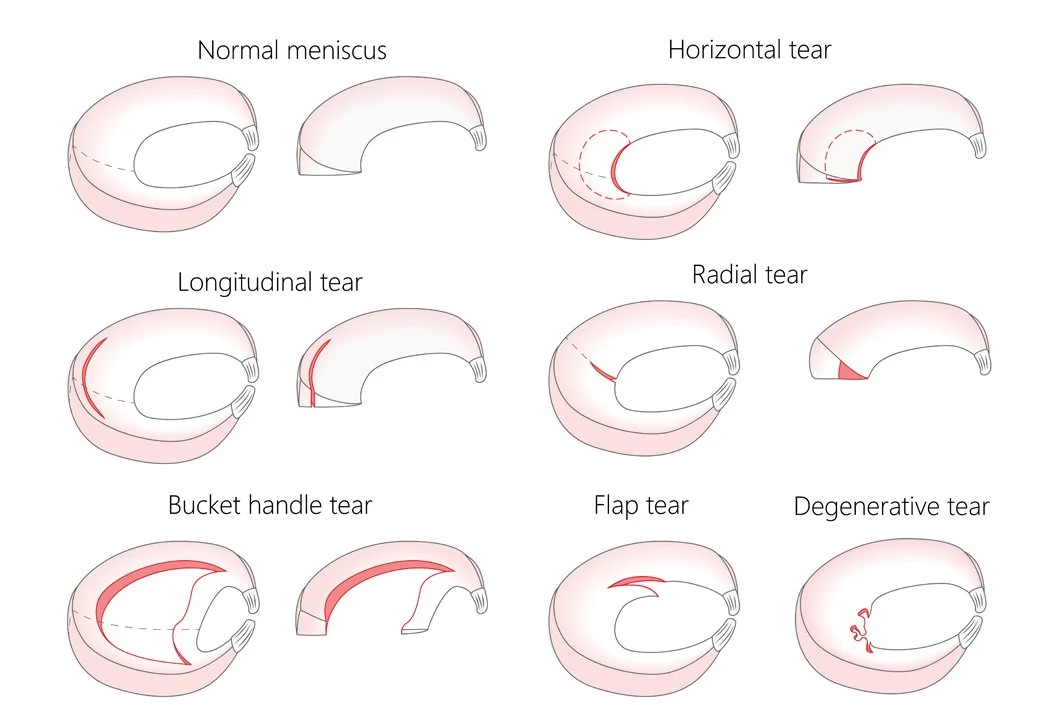What is a Knee Meniscal Tear and Can Physiotherapy Help?
The knee is both one of the most complex joints in the body and also one that comes under substantial load with sporting activities and day-to-day life. For this reason it is susceptible to a variety of injuries and conditions, including meniscal tears. In this article, we will explore what a knee meniscal tear is, the symptoms and causes, and most importantly how physiotherapy can help.
What is a Knee Meniscal Tear?
A meniscus tear is a common knee injury that occurs when the meniscal tissue in the knee joint is damaged. The meniscus is a crescent-shaped edge around your knee that acts as a cushion between the femur (thighbone) and the tibia (shinbone), absorbing shock and stabilising the knee joint, preventing it from moving where we don’t want it to go. You have both a medial (inside knee) and lateral (outside knee) meniscus as shown in images below.
Additionally, there are several types of meniscal injuries and these vary in severity and also in ability to heal naturally. Generally speaking, meniscal tears that occur closer to the outside edge of the meniscal tissue have a greater potential to heal well with Physio and tears that progress inward have less potential to heal without surgical intervention. This is largely due to the fact that the outside rim o the meniscus has a degree of blood flow and therefore healing potential, where as the inner parts do not.
Symptoms and Causes of a Knee Meniscal Tear
Symptoms of a knee meniscal tear can include pain, swelling, and stiffness in the knee, as well as a popping or clicking sound when moving the joint. In certain circumstances the meniscus can even ajar within the knee joint, causing the knee to lock. The causes of a meniscal tear can be due to several factors including ageing, injury, and overuse. Sometime it can be difficult to notice swelling that is hiding inside the knee joint. Swelling around the knee can be clearly seen but swelling inside the actual joint is not as clear and is often a key indicator for a meniscal tear.
Diagnosis and Treatment of a Knee Meniscal Tear
Diagnosis of a knee meniscal tear can be done through a physical examination with your Physio, and when required imaging tests such as an MRI can be ordered by your Physio to investigate further. The Physiotherapist can perform a McMurray test to ascertain the health of the meniscal tissue in your knee and in conjunction with other tests and assessments decide if the diagnosis of a meniscal tear is appropriate.
As mentioned above meniscal tears can heal when managed successfully with a quality, individualised physiotherapy program. Some of the options your Physio my choose to empty could include:
Cycling: This is an excellent way to help reduce swelling and encourage the meniscal to heal. It is best performed on a stationary recumbent bike and without symptom provocation.
Manual therapy: Hands-on therapy to assist the swelling to clear, endorse blood flow, and release tight tissue around the injured knee. This will also help substantially reduce the pain and improve function.
Cryotherapy: This has the dual effect of reducing swelling and inflammation. As the inflammation settles the pain and function will improve, and as the swelling reduces the knee will have improved range of motion.
Taping: This can be used as an effective tool to unload and support tissue around the injured knee.
Strength training: This is a key aspect to a successful Physiotherapy program but must only be undertaken with the supervision of your Physio, to understand which exercises are most appropriate and how heavy to lift.
Proprioception training: Essentially balance work, but done in a way that assists the knee to restore full function back and limit future injury.
In severe cases, surgery may be necessary to repair or remove the damaged portion of the meniscus and restore function to the knee.
Can Physiotherapy Help with a Knee Meniscal Tear?
Yes, physiotherapy can be a helpful treatment option for those with a knee meniscal tear. Physiotherapy can help to improve range of motion, reduce pain and swelling, and strengthen the muscles surrounding the knee. A physiotherapist can also provide exercises and activities to help prevent future injuries to the knee.
Can I run after a meniscal tear to my knee?
This is a common question we get asked a lot. The answer is yes, but there is a little more to it than that. It will depend on the type of tear, the degree of image and if that damage was done in isolation I.e. in conjunction with other tissue in the knee and also the successfulness of your physiotherapy program.
Benefits of Physiotherapy for Knee Meniscal Tears
Some of the benefits of physiotherapy for knee meniscal tears include reducing pain, improving mobility and flexibility, and preventing future knee injuries. Physiotherapy can also help to improve overall knee stability and strength, reducing the risk of reinjury.
How to Find a Qualified Physiotherapist in the Sutherland Shire for Knee Meniscal Tears
When looking for a physiotherapist to treat a knee meniscal tear, it is important to choose someone who is experienced and qualified. You can ask your doctor for recommendations or check with your local physiotherapy clinic for a list of qualified practitioners experienced in this area.
Conclusion
Knee meniscal tears are a common and painful injury that can cause discomfort and limit mobility. While rest and over-the-counter pain medications can help, physiotherapy can provide a more comprehensive and effective treatment solution. With the help of a qualified physiotherapist, you can reduce pain, improve mobility, and prevent future knee injuries. If you have experienced a knee meniscal tear, consider talking to your doctor about the benefits of physiotherapy for your condition.



